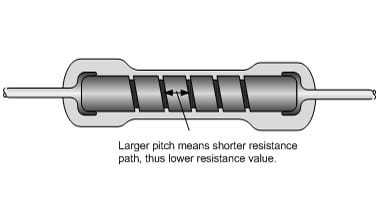Carbon Film Resistors
R3.7 CARBON FILM RESISTORS
Carbon film resistors sometimes are called surface layer resistors. Better qualities are classified as “stable” with a ΔR/R that will stop at ≤1%. Their role has, to a great extent, been taken over by the metal film but they still have a market, especially as cheap 5 per cent E 24 components. At new designs one should yet consider replacing them with metal film resistors that also are offered in E 24, 5 per cent.



If we apply crystalline carbon on ceramic rods in a vacuum chamber or if we heat them up to temperatures close to 1000 °C and then let them be hit by hydrocarbons, carbon will be deposited at a cracking process which will produce a stable, resistive carbon film with TCR values between –250 and –1000 ppm/°C depending on the resistance value. The thickness typically varies between 0.04 and 40 μm (1.6 and 1600 microinches). Low resistance values and corresponding thick films give an excellent pulse capability that may be further amplified if the film is non-spiraled.
Somewhere below 10Ω the manufacturers pass from carbon film to metal films (nickel, chromium-nickel or nickel-phosphorous) that is applied in a chemical bath or burning process or in an electrolytic bath. Thus, the user should carefully note in the catalogue sheets at which resistance value the TCR alters from, for example, –250 to maybe ±200 ppm/ °C.
The stability of carbon film resistors is good. The noise is comparatively high and increases with the resistance; low values may be relatively noise free, equivalent to that of the metal oxide.
High ohmic types exist in their most exclusive form in a hermetically sealed state, usually glass tubes, and may reach TΩ values (x 1012). Don’t touch such components with your fingers. Perspiring hands might be enough for shunting down the rated resistance markedly.
Table R3-4 CARBON FILM RESISTORS

